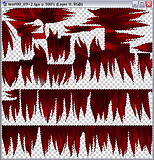Yes, I've finally made the second part of my intro to hacking guide series. This will be more of a list of advanced techniques and tricks that'll help you make textures.
An Intro To Hacking Part 2: Advanced TexturingNeeded- Photoshop (This tutorial will be written for Photoshop 7.0 but it should work with most programs)
- ASH
- ntcompress and texconv. These can be found in the Revolution SDK which I cannot provide a link to.
- Character .pacs
- Basic Photoshop Knowledge (Mainly what the polygonal lasso is)
- Basic Texure Hacking Knowledge
Advanced Techniques(Click thumbnail for full picture)
+1 and +2 Textures1. You'll often come across a texture with +1 or +2 in its name. These textures require indexing or ASH will return an error.
2. For my example we'll use Ike's hair, so extract an Ike .pac and open the tga in Fit_Ike_Hair.

3. Edit whatever you feel like in Ike's hair. In my case I turned it bright red.

4. Go to Image>Mode>Indexed Color. Only do this when you're completely done editing the texture.

5. Set the pallet to Local (Perceptual, uncheck transparency and type the amount of colors the texture can have in the color box.

5a. To find the color limit for a texture, run ASH. It'll ask you the index textures first, so just press no until you come to the texture you're editing. It says the colors allowed under the name.
6. Compile normally and you're done!
Transparency In +2 Textures(This is copied from a guide I made a while ago.)
Step 1: Open your chosen +2 texture in Photoshop. For my example we'll use Ike's hair.

Step 2: Edit whatever you wish about the texture. In my example, I applied the chrome filter.

Step 3: Click on the color picker for the foreground and change it to 255,0,255. Press ok.

Step 4: Select the brush tool and draw a little bit of magenta in an area where it's not touching any of your texture.

Step 5: If you haven't already, select the texture by control clicking the layer with your texture on it. Go to Image>Mode>Indexed Color. Set the pallet to local(perceptual), uncheck transparency and type the amount of colors the texture has in the color box (in Ike's case, 256).

Step 6: Almost done. Press ctrl+shift+I (Windows) to invert your selection. Go to Edit>Fill and choose foreground color (make sure the magenta is still set as your foreground color).

Step 7: Done! Now save it and compile it using ASH, and poof! No magenta outline!
Blending Modes1. If done correctly, blending modes can help your texture look a lot better.
2. Since we already have Ike open, let's use him again. I opened up Ike01, created a new layer, and plopped down a random brush.

3. Looks pretty bad, right? Well let's try using blending modes to make it blend in more. The blending modes drop down box is circled.

4. I recommend just randomly selecting options until you find something that looks good, but here are some of my more commonly used ones:
Lighten:

Darken:

Soft Light:

Hard Light (You can't see the difference here, but try it with other stuff):

Overlay (You can't see the difference here, but try it with other stuff):

Difference (This can create some cool effects, but use it selectively):

 Tips
Tips-It's not dishonorable to use premade textures! Look online for a good texture site that has cloth, metal, or whatever else you need and add it into your textures. Just beware of making your texture look to busy and be aware that it may be stretched out.
Next up: Stage textures!
If anybody has something to add to this guide, post and I'll add it.